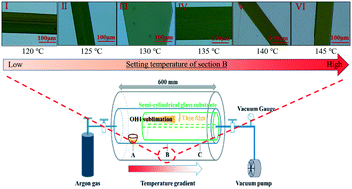Effect of growth temperature conditions on the optimization of OH1 single-crystalline thin film by physical vapour deposition
Abstract
2-(3-(4-Hydroxystyry1)-5,5-dimethylcyclohex-2-enylidene) malononitrile (OH1) is the only organic nonlinear optical (NLO) crystal that can be crystallized by physical vapour deposition (PVD) for terahertz (THz) wave generation. We report some optimizations of the growth temperature conditions of single-crystalline thin film by PVD. After transforming the setting temperature conditions from 90–120–180 °C to 90–145–180 °C, we observed that the temperature conditions influence the size of the OH1 single-crystalline thin film. Moreover, we found that, when the temperature gradient conditions were held at 90–135–180 °C during PVD for the growth of OH1 single-crystalline thin film, the single-crystalline thin films had longer b-axial extensions, which may be better-suited to nonlinear optics. The infrared transmission spectroscopy absorption peak positions of the OH1 single-crystalline thin film fabricated in this study were the same as those of bulk OH1 crystal. The crystallinity of the OH1 single-crystalline thin film was higher than that of bulk OH1 crystal, under all temperature conditions.



 Please wait while we load your content...
Please wait while we load your content...
